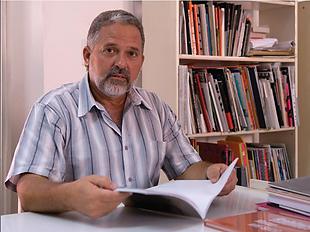Interview with Jose Manuel Noceda
By Xenia Reloba and Hector Bosch
In the middle of assembling the Shared Creations (Creaciones compartidas) collective exhibition, that brings together 19 artists from 11 countries, we talked with one of its curators, Jose Manuel Noceda, about the objectives and particularities of the exhibition that will be staged at the Pabellón Cuba, a recurrent venue of the Havana Biennial.
About the venue, Noceda pointed out that during the first Biennial, in 1984, the building «became a sort of temporary museum. It had two stories to exhibit works, particularly for the two-dimensional ones.» Then it was dropped for a few years, until the Biennial returned to «this emblematic and well-located site in what is today the center of the city, with its wonderful, atypical yet fabulous spaces,» in 2000.
According to Noceda, who shares the curatorship of Creaciones compartidas along with young Cuban artist Rewell Altunaga, «the curatorial logic has changed based on the interests for which Pabellon is conceived in the Biennial.» In the seventh edition (2000) works were in tune with the scale of the building, its monumentality, and were located in a way that they could interact with that structure. In the following years, greater emphasis was made on the context and history of the place, «one of the jewels of the revolutionary architecture, thought out to serve as the venue of big cultural events.»
However, « Creaciones compartidas takes another way. It tries particularly to articulate a bond with the current uses given to Pabellon, which has passed from being a space for big cultural events to a fair or exhibition ground; and I think those characteristics have given it a more popular touch. The public that enters the place is much more diverse and broader now. We are taking those uses as reference points and, some of the cultural trade operations that take place here during those events as well. »
The works of art
Regarding the pieces that the public will be able to see at Pabellon Cuba during the Eleventh Havana Biennial, Jose Manuel Noceda explained that «they have a playful and interactive character. Basically, what people we’ll find here after the 13th, the day the exhibition is inaugurated, at 10:00am, requires the presence, the participation of the viewer so that the production-circulation-consumption cycle is closed.» «There’s nothing there solely for the eye, to be look at. The artist has to enter a space and get in tune with the surrounding sound.»
In reference to the diverse nature of the works, he added that «some of them are just sounds; there is nothing physical in the space, following the immateriality of art. Others are installations that also emit sounds or encourage viewers to come in, touch, look, I mean, become familiar with the work from a much closer perspective.»
«That’s why I keep saying that this is one of the Biennial’s projects that tries to break with that kind of indifference typical of too wide publics towards contemporary art. Because it brings them closer to the productions by means of playful actions and interaction,» he stressed.
The boundaries of visual arts

When asked whether this project breaks or not the boundaries of visual arts, he answered categorically: «On the contrary. As all visual arts, we enter a much wider range of action than that of plastic arts, particularly with the development of the video, of the new communication means, of the use of technology according to the artistic expression.»
«Here we have productions that work precisely with those technologies, on digital formats, not just the video. It’s not just getting to the place and playing the film, there is the case in which a digital image can be activated from determined components located in the place that detect the presence of the viewer, follow him and project that presence, both with images and sounds,» Noceda said, in reference to the project by Cuban Aluan Arguelles.
The Caribbean and Central America at the Biennial
We asked about the participation of Latin American and Caribbean artists at this Eleventh Havana Biennial. «I’d rather say Caribbean and Central American,» and added: «the presence of those regions in the Biennial has been remarkable.»
«Over the last 20 or 25 years, an accelerated rupture with what had been happening in the past was produced. Those were cultural territories dominated by painting, printmaking, and, in a lesser extent, photography, but artists —especially the up-and-comers— have been giving a U-turn to those scenarios.»
«This time, the presence is smaller in terms of number, but they are relatively young, world-class artists who enjoy a considerable interregional and international circulation, and who fit nicely in the Biennial’s curatorial platform, » he explained.
Noceda mentioned as an example Panamanian Humberto Velez as «having him as a reference is must, precisely because the constant bond with the public sphere in his works. A Central American artist who lives in Manchester, England, and was a key point in our theoretical discussions as we organized the project and thought about the possible guest artists. He served as a paradigm many times.»
The specialist also talked about a group of artists «equally interesting and appealing, who work with popular imageries, », among them Jean François Bocle, from Martinique, whose creation is based on «all the postcolonial reflection on the Caribbean, » and Joëlle Ferly, from Guadalupe, who makes «a sort of relational performance involving the viewer. »
«In general —he said— it’s a not so-big selection in terms of number, but it is quite solid regarding the artists we have invited.»










